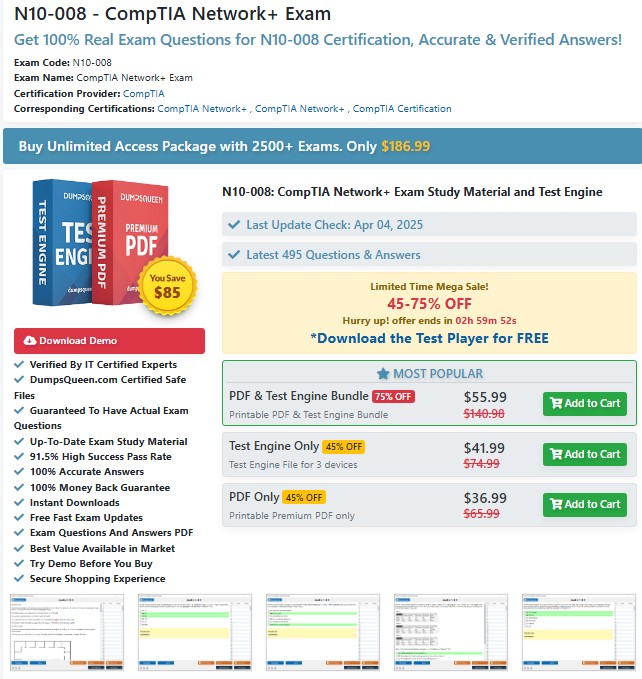Introduction
In the ever-evolving landscape of the internet, understanding the structure of website addresses is crucial for anyone navigating the digital world. At the heart of every website’s address lies the domain name, and a critical component of this is the top-level domain (TLD). But what exactly is a top-level domain, and why does it matter? For professionals preparing for IT certifications or students delving into networking concepts, questions like “Which of the following is an example of a top-level domain?” often arise in exams and discussions. This blog, crafted by DumpsQueen, aims to demystify the concept of top-level domains, explore their types, significance, and evolution, and provide clarity for learners and professionals alike. Whether you’re studying for a certification or simply curious about how the internet works, DumpsQueen is here to guide you through this essential topic with precision and expertise.
What is a Top-Level Domain?
A top-level domain, commonly referred to as a TLD, is the last segment of a domain name, appearing after the final dot in a website’s address. For instance, in the URL “www.example.com,” the “.com” is the top-level domain. TLDs are a fundamental part of the internet’s Domain Name System (DNS), which translates human-readable domain names into IP addresses that computers use to locate websites. The DNS operates hierarchically, and TLDs sit at the highest level of this hierarchy, making them a cornerstone of internet navigation.
TLDs serve as a way to categorize and organize websites based on their purpose, geographic location, or ownership. They provide a quick indication of what a website might be about. For example, a website ending in “.edu” is typically associated with educational institutions, while “.gov” is reserved for government entities. Understanding TLDs is not only important for browsing the internet but also for professionals in fields like cybersecurity, web development, and IT, where domain management plays a critical role.
At DumpsQueen, we recognize that mastering concepts like TLDs is essential for success in IT certifications such as CompTIA Network+, Cisco CCNA, or AWS certifications. That’s why we’re diving deep into this topic to ensure you have the knowledge needed to excel.
The History and Evolution of TLDs
The concept of top-level domains dates back to the early days of the internet in the 1980s, when the DNS was developed to make online navigation more intuitive. The first TLDs were introduced in 1985, and they included a small set of generic options like “.com” (for commercial entities), “.org” (for organizations), “.net” (for network-related entities), “.edu” (for educational institutions), “.gov” (for government bodies), and “.mil” (for military use). Additionally, country-code TLDs (ccTLDs) like “.uk” (United Kingdom) and “.jp” (Japan) were established to represent specific geographic regions.
Initially, the number of TLDs was limited, and their management was overseen by the Internet Assigned Numbers Authority (IANA), under the supervision of the U.S. Department of Commerce. However, as the internet grew exponentially, the demand for more diverse and specific TLDs surged. By the early 2000s, new TLDs like “.info,” “.biz,” and “.name” were introduced to accommodate the expanding digital landscape.
The most significant change came in 2011 when the Internet Corporation for Assigned Names and Numbers (ICANN), the organization responsible for coordinating the global DNS, launched the New gTLD Program. This initiative allowed organizations to apply for custom TLDs, leading to the creation of hundreds of new options like “.shop,” “.blog,” “.app,” and even brand-specific TLDs like “.google” or “.apple.” Today, there are over 1,500 TLDs available, reflecting the diversity and complexity of the modern internet.
For those studying with DumpsQueen, understanding the evolution of TLDs provides valuable context for certification exams, where questions about domain structures and their historical development may appear.
Types of Top-Level Domains
To fully grasp the question “Which of the following is an example of a top-level domain?” it’s essential to explore the different categories of TLDs. Each type serves a unique purpose and is governed by specific rules.
Generic Top-Level Domains (gTLDs)
Generic top-level domains are the most recognizable and widely used TLDs. They are not tied to a specific geographic location and are intended for general purposes. The original gTLDs, like “.com,” “.org,” and “.net,” remain the most popular, but the introduction of new gTLDs has expanded the options significantly. Examples include “.info” (for informational sites), “.biz” (for businesses), and “.online” (for general online presence).
New gTLDs introduced after 2011 cater to specific industries, communities, or interests. For instance, “.tech” is popular among technology companies, while “.art” is used by artists and galleries. Some gTLDs, like “.museum” or “.aero,” are restricted to specific organizations, requiring verification to register.
At DumpsQueen, we emphasize the importance of recognizing gTLDs in certification exams, as they often appear in multiple-choice questions about domain structures.
Country-Code Top-Level Domains (ccTLDs)
Country-code top-level domains are two-letter TLDs assigned to specific countries or territories based on the ISO 3166-1 standard. Examples include “.us” (United States), “.ca” (Canada), “.de” (Germany), and “.cn” (China). These TLDs are typically managed by organizations within the respective countries and are used to indicate a website’s geographic or cultural affiliation.
While ccTLDs were originally intended for local use, some have gained global popularity. For example, “.co” (Colombia) is often used by companies as an alternative to “.com,” and “.tv” (Tuvalu) is marketed for television-related websites. Understanding ccTLDs is crucial for professionals working in international markets or studying global networking protocols.
DumpsQueen’s resources help learners differentiate between ccTLDs and other TLD types, ensuring clarity when tackling exam questions.
Sponsored Top-Level Domains (sTLDs)
Sponsored top-level domains are a subset of gTLDs that are managed by specific organizations or communities with defined eligibility criteria. Examples include “.edu” (sponsored by educational institutions), “.gov” (sponsored by the U.S. government), and “.int” (for international organizations). These TLDs are highly regulated, and only qualifying entities can register domains under them.
For IT professionals, recognizing sTLDs is important for understanding domain governance and restrictions, topics often covered in certifications like CompTIA Security+ or ITIL.
Infrastructure and Special-Use TLDs
A lesser-known category includes infrastructure and special-use TLDs, such as “.arpa,” which is used for internet infrastructure purposes like reverse DNS lookups. Special-use TLDs, like “.localhost” or “.example,” are reserved for testing or documentation and are not available for public registration.
While these TLDs are less common in everyday browsing, they are relevant for networking professionals and may appear in advanced certification exams. DumpsQueen ensures you’re prepared for such niche topics with comprehensive study materials.
Why Top-Level Domains Matter
Top-level domains play a pivotal role in the functionality and perception of websites. From a technical perspective, TLDs are integral to the DNS, enabling the resolution of domain names to IP addresses. Without TLDs, the internet would lack the structure needed for efficient navigation.
From a branding perspective, TLDs influence how users perceive a website. A “.com” domain is often seen as established and trustworthy, while a “.org” domain suggests a nonprofit or community focus. New gTLDs like “.shop” or “.blog” allow businesses to create memorable and relevant domain names that align with their brand identity.
For professionals, TLDs also have implications in areas like cybersecurity. For example, certain ccTLDs may be associated with higher risks of phishing or malware, making domain reputation a key consideration in security certifications. Additionally, understanding TLDs is essential for tasks like domain registration, DNS configuration, and website management.
At DumpsQueen, we highlight the practical applications of TLD knowledge, helping you connect theoretical concepts to real-world scenarios in your certification journey.
Common Misconceptions About TLDs
Despite their importance, TLDs are often misunderstood. One common misconception is that a TLD determines a website’s content or quality. While TLDs provide clues about a site’s purpose, they don’t guarantee accuracy or legitimacy. For example, a “.edu” domain suggests an educational institution, but it doesn’t ensure the site’s content is authoritative.
Another misconception is that all TLDs are universally available. In reality, some TLDs, like “.gov” or “.mil,” have strict eligibility requirements, and even certain ccTLDs may require local presence or documentation to register.
Finally, some believe that “.com” is the only TLD worth using. While “.com” remains dominant, new gTLDs and ccTLDs offer valuable alternatives, especially for niche markets or creative branding.
DumpsQueen’s study resources clarify these misconceptions, ensuring you approach TLD-related exam questions with confidence and accuracy.
How DumpsQueen Can Help You Master TLDs and More
At DumpsQueen, we’re committed to empowering learners with the knowledge and tools needed to succeed in IT certifications and beyond. Our official website, DumpsQueen, offers a wealth of resources, including study guides, practice exams, and detailed explanations for topics like top-level domains, DNS, and networking fundamentals. Whether you’re preparing for CompTIA, Cisco, or other certifications, our expertly crafted materials ensure you understand complex concepts with ease.
By exploring topics like TLDs through DumpsQueen’s platform, you’ll gain the confidence to tackle exam questions and apply your knowledge in real-world scenarios. Visit DumpsQueen today to discover how we can support your learning journey.
Conclusion
Top-level domains are more than just the endings of website addresses—they’re a vital part of the internet’s infrastructure, shaping how we navigate and perceive the digital world. From generic TLDs like “.com” to country-code TLDs like “.uk” and sponsored TLDs like “.edu,” each type serves a unique purpose and carries specific implications for users and professionals alike. Understanding questions like “Which of the following is an example of a top-level domain?” is essential for anyone studying IT, networking, or cybersecurity, as TLDs frequently appear in certification exams and real-world applications.
With the internet continuing to grow, the role of TLDs will only become more significant, making it crucial to stay informed about their types, uses, and governance. DumpsQueen is proud to be your trusted partner in this journey, offering expert resources to help you master TLDs and countless other topics. Visit the official DumpsQueen to explore our offerings and take the next step toward achieving your certification goals. Let’s navigate the digital world together, one domain at a time.
Free Sample Questions
Question 1: Which of the following is an example of a top-level domain?
A) www
B) .com
C) example
D) http
Answer: B) .com
A) .org
B) .uk
C) .info
D) .edu
Answer: B) .uk
A) .gov
B) .int
C) .mil
D) .biz
Answer: B) .int
A) .com
B) .net
C) .shop
D) .org
Answer: C) .shop



